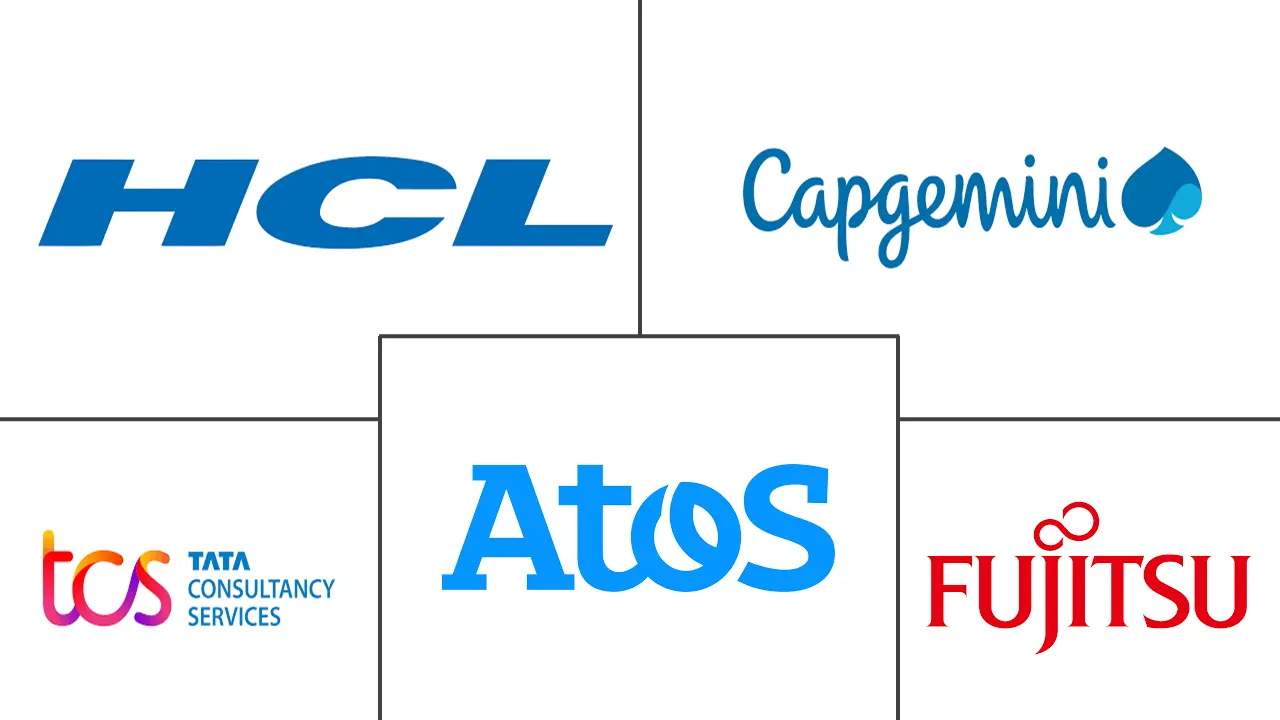Managed Digital Workplace Services Market Size and Share
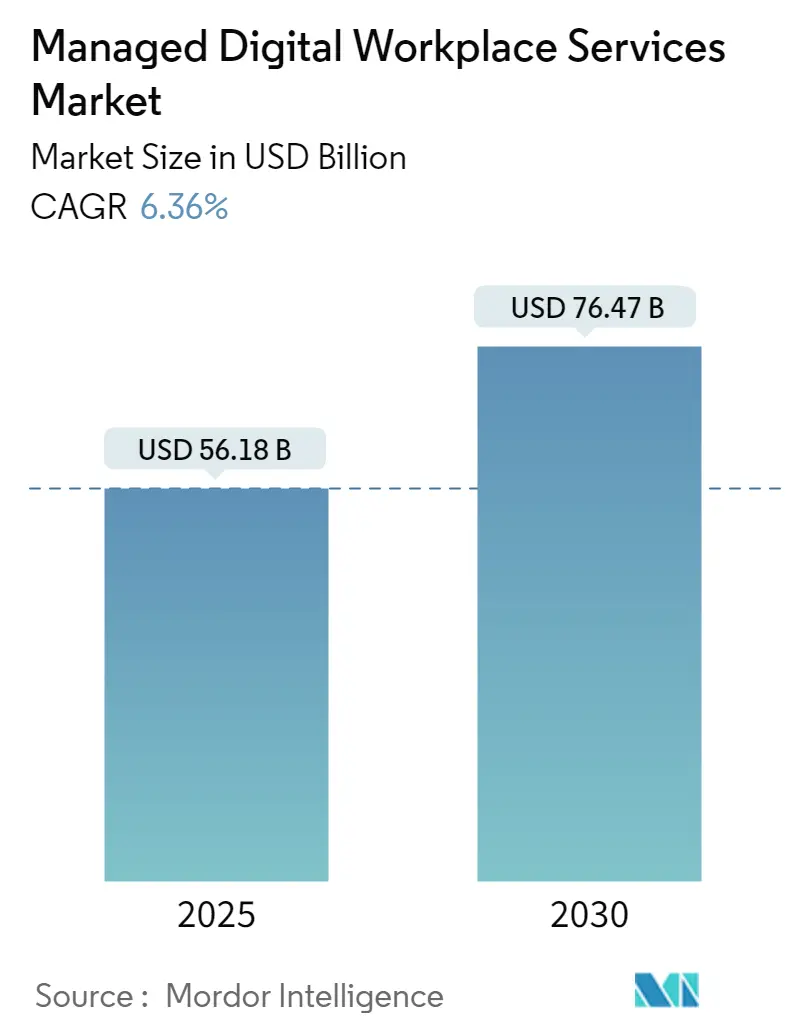
Managed Digital Workplace Services Market Analysis by Mordor Intelligence
The Managed Digital Workplace Services Market size is estimated at USD 56.18 billion in 2025, and is expected to reach USD 76.47 billion by 2030, at a CAGR of 6.36% during the forecast period (2025-2030).
The managed digital workplace services landscape is experiencing significant transformation driven by technological advancement and changing workforce dynamics. According to a comprehensive survey conducted by Beautiful.ai in 2022, 78% of managers acknowledge substantial financial resources being directed toward achieving successful digital workplace transformation, while 80% of organizations are committed to investing in technology tools to support management goals. The integration of artificial intelligence has become increasingly crucial in workplace operations, enabling organizations to streamline workflows through automated tasks and intelligent insights. These technological shifts have particularly impacted areas such as knowledge management, data governance, and end-user experience management, fundamentally reshaping how organizations approach workplace efficiency.
The manufacturing sector's embrace of smart technologies has emerged as a significant trend shaping the industry landscape. According to Deloitte's 2022 survey, 45% of manufacturing executives are actively seeking opportunities for industrial IoT investments to enhance operational efficiency, while 82% anticipate increased spending on cybersecurity measures. This technological evolution has led to the emergence of sophisticated workplace management solutions that integrate IoT devices, connected equipment, and smart sensors, enabling proactive issue identification and automated service request management.
Major technology companies are making substantial investments to enhance their digital workplace offerings and capabilities. In February 2023, Microsoft announced a $1 billion investment in 5G startup Airspan to improve workplace connectivity, followed by Cisco's $2 billion investment in Webex in March 2023 to accelerate collaboration platform development. Similarly, SAP's $1 billion investment in Slack in April 2023 demonstrates the industry's commitment to enhancing integrated business collaboration solutions, reflecting the growing importance of seamless digital employee experience tools.
The industry is witnessing a significant shift toward comprehensive modern workplace solutions that prioritize employee experience and engagement. In May 2023, Lenovo introduced its Digital Workplace Solutions, focusing on improving employee experience and productivity through end-to-end services built on advanced platforms. These solutions encompass device infrastructure management, next-generation IoT devices, and optimized Bring Your Own Device (BYOD) policies, reflecting the industry's evolution toward more integrated and user-centric workplace management approaches. The emphasis on employee experience has become particularly crucial as organizations seek to maintain productivity and engagement in increasingly diverse work environments, underscoring the importance of enterprise mobility management and workplace modernization services.
Global Managed Digital Workplace Services Market Trends and Insights
Higher Levels of Digitization in the Service Desk for Contact Resolution
The integration of digital technology and automation has fundamentally transformed how businesses handle customer contacts and support their workforce. Service desk digitization enables organizations to deliver faster and more efficient customer support through automated self-service options, chatbots, and AI-powered virtual assistants. According to a PwC survey, 73% of consumers consider customer experience crucial in their purchasing decisions, highlighting the importance of efficient service desk operations. The implementation of digital service desks also allows organizations to reduce operational costs significantly, with Gartner reporting that automation is expected to result in a 70% decrease in service desk ticket volumes by the end of 2023.
Service desks can now leverage machine learning and predictive analysis to anticipate client needs and proactively address potential issues. By analyzing historical data and patterns, service desks can identify potential problems and offer preventive solutions, improving customer satisfaction while reducing support tickets. Self-service portals and knowledge bases enable users to access FAQs, how-to guides, and other helpful resources for independent problem-solving. The automation of service requests reduces manual intervention and response times, with tools that streamline ticket creation, routing, and assignment ensuring faster resolution and greater efficiency. Additionally, the integration of collaboration technologies into service desks enables support teams to communicate and resolve issues more effectively, with real-time communication tools and file-sharing capabilities accelerating problem resolution.
Increase in Adoption of Digital Solutions as Part of Digital Transformation Initiatives
Organizations worldwide are embracing digital transformation to maintain competitiveness, increase operational effectiveness, and boost employee productivity. According to a 2022 survey by beautiful.ai, 78% of organizations agree that significant financial resources are being directed toward achieving successful digital workspace solutions, while 80% confirmed their commitment to investing in technology and tools to assist managers in successfully leading and meeting goals in a digital workplace. The 2022 State of Digital Workplace survey further revealed that 86% of respondents considered a digital workplace crucial to their daily work, demonstrating the growing importance of digital workspace solutions in modern business operations.
The adoption of digital solutions has been particularly evident in the integration of advanced technologies and automation capabilities. According to a ManageEngine survey, 91% of decision-makers in India agreed that collaboration between IT and business departments had strengthened in recent years, highlighting the successful implementation of digital transformation initiatives. Organizations are increasingly focusing on enhancing employee experiences through advanced digital tools and solutions, with Deloitte reporting that 85% of executives consider digital employee experience a strategic priority. These digital workplace solutions provide seamless access to applications, data, and collaboration tools, regardless of location, while ensuring robust security measures and compliance with regulatory requirements.
Rise of Work from Home Employees with Several Companies Considering it as a Permanent Alternative
The transformation of traditional work models has led to a significant shift in how organizations approach workplace management and technology implementation. Major corporations are increasingly adopting permanent remote work policies, with companies implementing sophisticated digital workspace solutions to support distributed workforce operations. These solutions encompass secure remote access capabilities, virtual private networks (VPNs), multi-factor authentication, and endpoint security protocols, ensuring that remote workers can safely access critical information and connect to company networks while maintaining data security and operational efficiency.
The success of remote work arrangements has been demonstrated through improved employee productivity and satisfaction levels. Organizations are investing in cloud-based applications and collaboration technologies to facilitate efficient communication and cooperation among remote teams. According to industry surveys, remote workers report better work-life balance and higher job satisfaction, driving companies to enhance their digital workplace infrastructure. This trend has led to increased adoption of cloud-based facilities management software, enabling business leaders to stay organized and up-to-date, resulting in improved business performance. Furthermore, digital workplace technologies have evolved to focus on advanced communication systems, information management, and cybersecurity, providing better workflows and data management capabilities for remote workforce operations. These advancements in workplace experience services and enterprise mobility management are crucial for supporting remote work environments.
Segment Analysis: By Service
Digital Workplace Segment in Managed Digital Workplace Services Market
The digital workplace managed services segment maintains its dominant position in the Managed Digital Workplace Services market, commanding approximately 39% of the market share in 2024. This segment's leadership is driven by the increasing adoption of comprehensive digital workplace solutions that integrate collaboration tools, cloud computing, mobility solutions, and physical and knowledge automation capabilities. Organizations are increasingly leveraging digital workplace managed services to create seamless, connected environments that enhance employee productivity and engagement. The segment's strength is further reinforced by the growing demand for unified platforms that integrate various applications, tools, and data, enabling employees to access and collaborate on their work from anywhere and on any device.
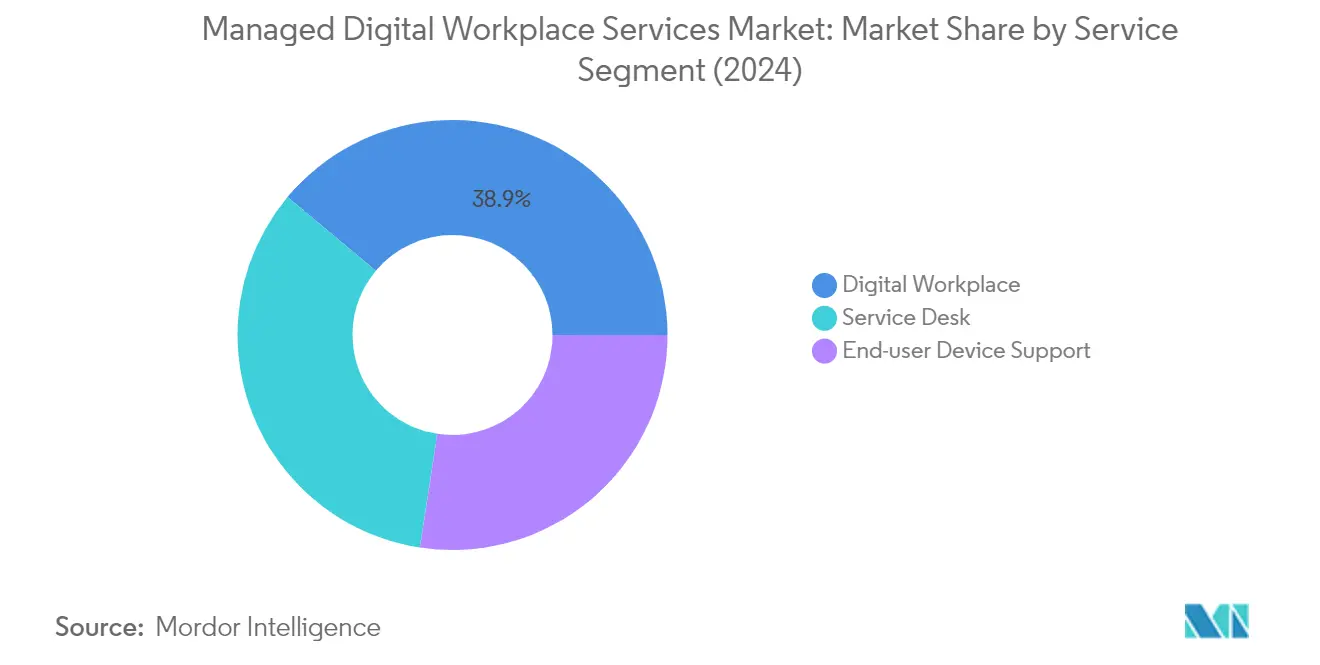
Service Desk Segment in Managed Digital Workplace Services Market
The Service Desk segment is emerging as the fastest-growing segment in the Managed Digital Workplace Services market, with an expected growth rate of approximately 8% during 2024-2029. This remarkable growth is primarily driven by the evolution of service desks from reactive, manual intervention-based support to intuitive, proactive, and digitally empowered solutions using next-generation technology and multi-channel strategies. The segment's growth is further accelerated by the increasing adoption of AI-powered service desk solutions, virtual assistants, and cognitive learning capabilities. Organizations are increasingly recognizing the value of modern service desk solutions in providing superior customer service, reducing downtime, and enhancing overall operational efficiency through automated incident resolution and proactive support mechanisms.
Remaining Segments in Service Segmentation
The End-user Device Support segment plays a crucial role in the Managed Digital Workplace Services market by providing comprehensive support for various end-user devices, including computers, laptops, smartphones, and tablets. This segment focuses on delivering essential services such as device lifecycle management, security implementation, patch management, and remote monitoring solutions. The segment's significance is amplified by the growing need for seamless device management in hybrid work environments, where organizations require robust support mechanisms to maintain productivity and security across distributed workforces. End-user Device Support services continue to evolve with the integration of advanced technologies like automation, AI-powered diagnostics, and predictive maintenance capabilities.
Segment Analysis: By End-User Vertical
BFSI Segment in Managed Digital Workplace Services Market
The Banking, Financial Services and Insurance (BFSI) sector represents approximately 27% of the managed digital workplace services market in 2024, establishing itself as a dominant vertical. This significant market share is driven by the sector's increasing transition toward customer-friendly, service-oriented environments where digitalized services have largely replaced traditional banking practices. The BFSI sector has embraced enterprise digital services to streamline operations, enhance customer engagement, and improve operational efficiency through features like digital signatures, paperless workflows, and automated processes. Financial institutions are leveraging these services to provide seamless digital experiences, enable remote work capabilities, and maintain robust security protocols while ensuring regulatory compliance.
Healthcare Segment in Managed Digital Workplace Services Market
The healthcare segment is experiencing remarkable growth in the managed digital workplace services market, with an expected growth rate of approximately 9% during 2024-2029. This accelerated growth is driven by the increasing need to reduce labor costs in hospitals and other health facilities, improve operational efficiency, and address the growing demand for healthcare professionals. Healthcare organizations are rapidly adopting workplace support services to transform their traditional workflows, implement telehealth platforms, and enhance patient care delivery systems. The integration of workplace analytics, automated scheduling systems, and digital collaboration tools is enabling healthcare providers to optimize staff productivity, streamline administrative processes, and deliver better patient outcomes while maintaining compliance with healthcare regulations.
Remaining Segments in End-User Vertical
The managed digital workplace services market encompasses several other significant verticals, including manufacturing, energy and utility, and government and public sector segments. The manufacturing sector is leveraging these services to optimize production processes, enhance supply chain management, and implement Industry 4.0 initiatives. The energy and utility sector is focusing on digital transformation to improve grid management, customer service, and operational efficiency. The government and public sector is implementing digital workplace solutions to enhance citizen services, streamline administrative processes, and improve public service delivery. Each of these segments contributes uniquely to the market's dynamics, with varying requirements for security, compliance, and operational efficiency driving the adoption of managed digital workplace services.
Managed Digital Workplace Services Market Geography Segment Analysis
Managed Digital Workplace Services Market in North America
North America represents the largest regional market for managed workplace services, commanding approximately 35% of the global market share in 2024. The region's dominance is primarily driven by the rapid adoption of emerging technologies such as artificial intelligence, BYOD policies, and corporate mobility management solutions. Organizations across various sectors, particularly in the United States and Canada, are increasingly embracing cloud technology and artificial intelligence integration into their service offerings. The presence of major technology vendors and early adoption of innovative managed digital workplace services has created a robust ecosystem for digital workplace services. The region's focus on enhancing cybersecurity measures, improving employee experiences, and optimizing operational efficiency through digital transformation has further strengthened its market position. Additionally, the growing trend toward hybrid work models and the need for seamless communication and collaboration among distributed teams have accelerated the adoption of comprehensive digital workplace solutions. The region's strong IT infrastructure, coupled with high digital literacy rates and substantial investment in workplace transformation initiatives, continues to fuel market growth.
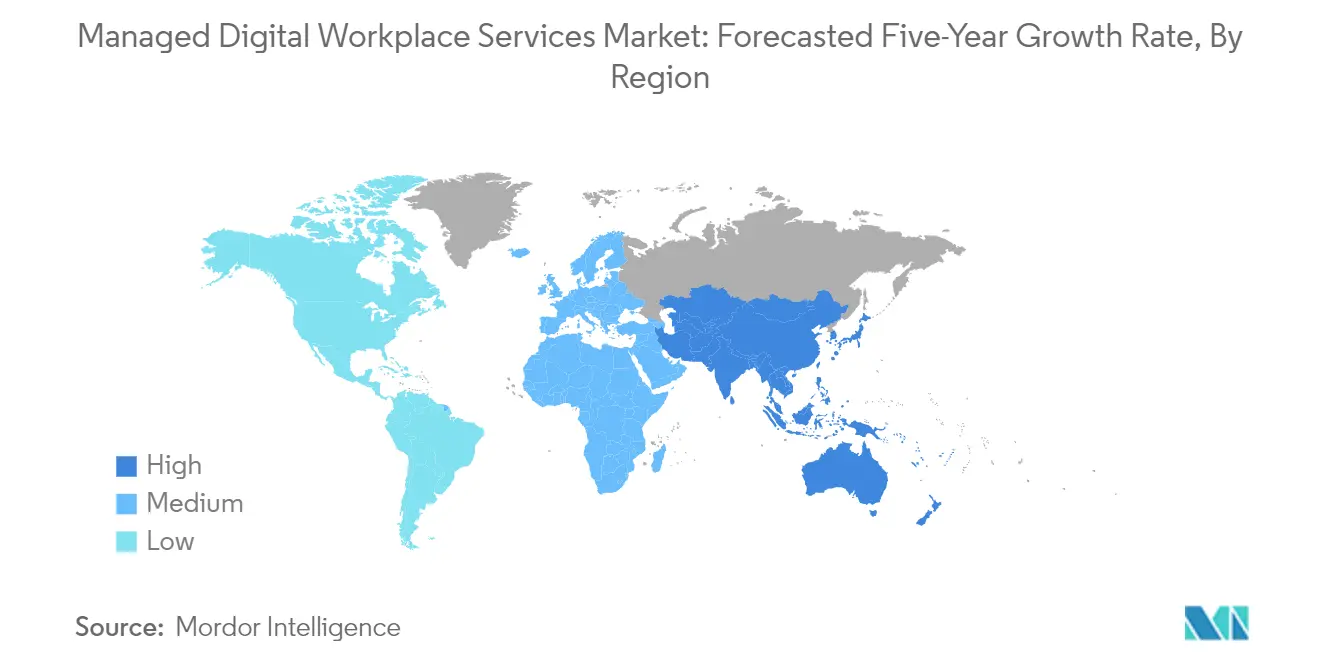
Managed Digital Workplace Services Market in Europe
Europe has demonstrated substantial growth in the digital enterprise services market, with an approximate growth rate of 6% during the period 2019-2024. The region's market expansion is characterized by increasing adoption of cloud computing and the implementation of stringent data protection regulations. European organizations are particularly focused on security services, driven by comprehensive regional legislation and compliance requirements. The presence of a strong automotive and manufacturing sector has created significant opportunities for specialized managed workplace services. The region's emphasis on digital transformation initiatives, particularly in countries like Germany, France, and the United Kingdom, has fostered innovation in workplace management solutions. European businesses are increasingly prioritizing employee experience and workplace flexibility, leading to greater investment in digital workplace infrastructure. The integration of advanced technologies, coupled with a strong focus on sustainability and efficient resource utilization, has created a distinctive market environment. Furthermore, the region's commitment to digital innovation and workplace modernization continues to drive the adoption of managed digital workplace services across various industries.
Managed Digital Workplace Services Market in Asia-Pacific
The Asia-Pacific region is positioned as the fastest-growing market for managed digital workplace services, with a projected growth rate of approximately 8% during the period 2024-2029. This robust growth trajectory is underpinned by rapid technological advancement and digital transformation initiatives across various sectors. The region's dynamic business environment, characterized by increasing digitalization efforts and the adoption of modern workplace solutions, has created substantial opportunities for market expansion. Countries like China, Japan, India, and Australia are leading the digital workplace revolution through significant investments in IT infrastructure and digital capabilities. The growing emphasis on employee experience, coupled with the rising adoption of cloud-based solutions and mobile technologies, has accelerated market growth. Organizations in the region are increasingly recognizing the value of IT workplace services in enhancing operational efficiency and maintaining competitive advantage. The presence of a large workforce, coupled with increasing digital literacy and technological adoption, has created a fertile ground for market expansion. Additionally, government initiatives supporting digital transformation and the modernization of workplace infrastructure continue to drive market growth across the region.
Managed Digital Workplace Services Market in Rest of the World
The Rest of the World region, encompassing Latin America, the Middle East, and other emerging markets, demonstrates significant potential in the managed digital workplace services market. These regions are experiencing a notable transformation in their approach to workplace management, driven by increasing digitalization and modernization initiatives. The healthcare sector, in particular, has emerged as a key adopter of digital workplace solutions, focusing on improving operational efficiency and service delivery. Organizations in these regions are increasingly recognizing the importance of digital transformation in maintaining competitive advantage and improving operational efficiency. The growing adoption of workplace technology services, coupled with increasing investment in IT infrastructure, has created new opportunities for market growth. The region's diverse economic landscape and varying levels of digital maturity present unique challenges and opportunities for service providers. Furthermore, the increasing focus on modernizing business operations and improving employee productivity continues to drive the adoption of managed digital workplace services across various sectors in these regions.
Competitive Landscape
Top Companies in Managed Digital Workplace Services Market
The managed digital workplace services market features prominent players like Atos SE, Fujitsu Ltd, HCL Technologies, Capgemini, TCS, Wipro, IBM Corporation, and DXC Technology leading the competitive landscape. These companies are driving innovation through AI-powered workplace solutions, intelligent automation, and advanced analytics capabilities to enhance employee experiences and operational efficiency. Strategic partnerships with technology providers like Microsoft, ServiceNow, and cloud platform providers have become crucial for expanding service portfolios and market reach. Companies are investing heavily in research and development to develop proprietary platforms and solutions while also focusing on sustainability initiatives in their digital workplace offerings. The market is characterized by continuous product evolution, with providers incorporating emerging technologies like cloud computing, IoT, and machine learning to deliver more sophisticated enterprise workplace services. Geographical expansion through delivery centers and strategic acquisitions has become a key growth strategy, particularly in emerging markets across Asia-Pacific and Latin America.
Market Consolidation Drives Competitive Dynamics Forward
The managed digital workplace services market exhibits a balanced mix of global IT conglomerates and specialized service providers, with large multinational corporations holding dominant market positions through their comprehensive service portfolios and extensive global delivery networks. Market consolidation is actively progressing through strategic acquisitions and partnerships, as evidenced by significant moves like Kyndryl's acquisition of Cloudreach and various strategic partnerships between major players and technology providers. The competitive landscape is characterized by intense rivalry among established players who are continuously expanding their capabilities through investments in emerging technologies and talent acquisition. These companies are leveraging their strong client relationships, industry expertise, and technological capabilities to maintain their market positions while actively pursuing growth opportunities in new geographical markets and industry verticals.
The market demonstrates a clear trend toward consolidation, with larger players acquiring smaller, specialized firms to enhance their technological capabilities and expand their market presence. Companies are increasingly focusing on building end-to-end service capabilities through both organic growth and strategic acquisitions, particularly in areas like artificial intelligence, automation, and cloud services. The competitive dynamics are further shaped by the growing importance of innovation capabilities, with companies investing in research and development centers and innovation labs to stay ahead of technological advancements. Regional players are also emerging as significant competitors, particularly in Asia-Pacific markets, where local knowledge and presence are becoming increasingly important for market success.
Innovation and Adaptability Drive Market Success
Success in the managed digital workplace services market increasingly depends on providers' ability to deliver innovative, customized solutions while maintaining operational efficiency and service quality. Market leaders are strengthening their positions through investments in proprietary platforms, advanced analytics capabilities, and AI-powered solutions, while also focusing on developing industry-specific expertise and solutions. The ability to provide seamless integration of various workplace technology services, ensure robust security measures, and deliver superior employee experiences has become crucial for maintaining competitive advantage. Companies must also demonstrate strong change management capabilities and the ability to support clients through digital transformation initiatives while addressing evolving regulatory requirements and compliance standards.
For contenders and new entrants, success lies in identifying and focusing on specific market niches or industry verticals where they can build specialized expertise and differentiated offerings. These players need to leverage partnerships with technology providers and focus on developing innovative solutions that address specific customer pain points or industry challenges. The market shows moderate barriers to entry due to the high capital requirements and need for specialized expertise, but opportunities exist for companies that can demonstrate unique value propositions and strong delivery capabilities. Regulatory compliance, particularly in areas like data privacy and security, continues to shape competitive strategies, while the increasing focus on sustainability and environmental considerations is emerging as a new differentiator in the market. Additionally, the demand for remote workplace services and workplace modernization services is driving companies to innovate and adapt their offerings to meet evolving client needs.
Managed Digital Workplace Services Industry Leaders
-
Atos SE
-
Fujitsu Ltd
-
HCL Technologies
-
Capgemini Services SAS
-
Tata Consultancy Services Limited
- *Disclaimer: Major Players sorted in no particular order
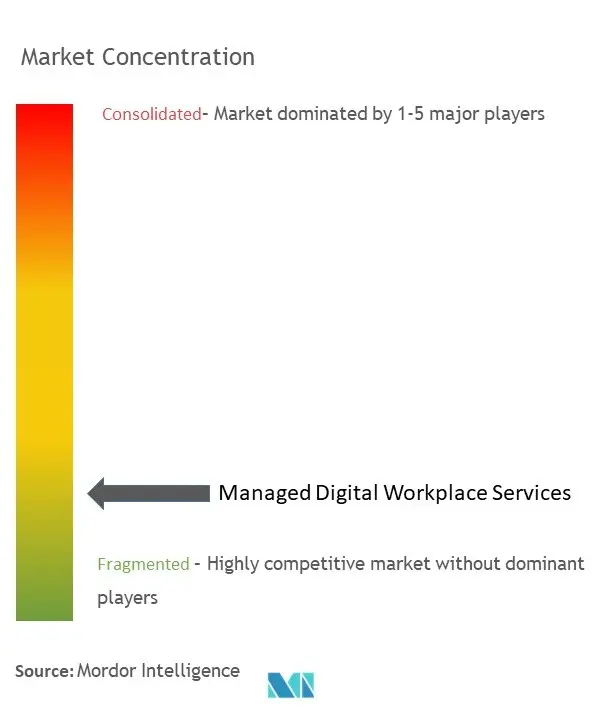
Recent Industry Developments
- June 2023: Tech Mahindra, a provider of digital transformation, business re-engineering, and consulting services and solutions, announced a collaboration with Espressive, an automating digital workplace assistance firm. The collaboration will offer their customers cost-effective and autonomous work environment assistance through Espressive Barista, an AI-based virtual support agent (VSA).
- May 2023: Lenovo Solutions and Services Group (SSG) launched Digital Workplace Solutions (DWS), a new managed services portfolio of intelligent tools and systems. Digital Workplace Solutions (DWS) delivers work-related technology, efficiency, security, and employee satisfaction so executives can achieve key performance outcomes.
- May 2023: Stefanini announced a new collaboration with the major automotive brand Mazda, having been appointed to provide an end-to-end workplace solution, including remote technical specialists, service desk support, local technical support, and enterprise services such as Office 365.
Global Managed Digital Workplace Services Market Report Scope
Managed digital workplace services provide an end-to-end approach to workflow processes through desktop delivery, mobility, service desk, collaboration, and user support while reducing operational IT costs. The study tracks the revenues generated from the services used in various end-user verticals across the globe. The income from the globally managed digital workplace services vendors and COVID-19's impact on market projection has also been considered.
The managed digital workplace services market is segmented by services (service desk, end-user device support, and digital workplace), end-user vertical (BFSI, healthcare, manufacturing, energy and utility, and government and public sector), and geography (North America, Europe, Asia-Pacific, and Rest of the world). The market sizes and forecasts are provided in terms of value in (USD) for all the segments.
| Service Desk |
| End-user Device Support |
| Digital Workplace |
| BFSI |
| Healthcare |
| Manufacturing |
| Energy and Utility |
| Government and Public Sector |
| Other End-user Verticals |
| North America |
| Europe |
| Asia-Pacific |
| Rest of the World |
| By Services | Service Desk |
| End-user Device Support | |
| Digital Workplace | |
| By End-user Vertical | BFSI |
| Healthcare | |
| Manufacturing | |
| Energy and Utility | |
| Government and Public Sector | |
| Other End-user Verticals | |
| By Geography | North America |
| Europe | |
| Asia-Pacific | |
| Rest of the World |
Key Questions Answered in the Report
How big is the Managed Digital Workplace Services Market?
The Managed Digital Workplace Services Market size is expected to reach USD 56.18 billion in 2025 and grow at a CAGR of 6.36% to reach USD 76.47 billion by 2030.
What is the current Managed Digital Workplace Services Market size?
In 2025, the Managed Digital Workplace Services Market size is expected to reach USD 56.18 billion.
Who are the key players in Managed Digital Workplace Services Market?
Atos SE, Fujitsu Ltd, HCL Technologies, Capgemini Services SAS and Tata Consultancy Services Limited are the major companies operating in the Managed Digital Workplace Services Market.
Which is the fastest growing region in Managed Digital Workplace Services Market?
Asia Pacific is estimated to grow at the highest CAGR over the forecast period (2025-2030).
Which region has the biggest share in Managed Digital Workplace Services Market?
In 2025, the North America accounts for the largest market share in Managed Digital Workplace Services Market.
What years does this Managed Digital Workplace Services Market cover, and what was the market size in 2024?
In 2024, the Managed Digital Workplace Services Market size was estimated at USD 52.61 billion. The report covers the Managed Digital Workplace Services Market historical market size for years: 2019, 2020, 2021, 2022, 2023 and 2024. The report also forecasts the Managed Digital Workplace Services Market size for years: 2025, 2026, 2027, 2028, 2029 and 2030.
Page last updated on:
